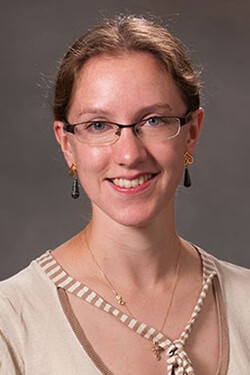
When COVID-19 closed the door on a visit from Cara Burberry’s friend and colleague, that colleague responded by opening a window — and chucking some digital rocks through it.
About five weeks ago, with the full scope of COVID-19 still obscured by conflicting anecdotes and limited data, Burberry was chatting by phone with a fellow geologist from the University of Arizona. Speculation about travel restrictions and social distancing had begun thrumming through both universities. Not long after, it would force the cancellation of a lecture that Burberry had invited her colleague to give at the University of Nebraska–Lincoln.

“But of course, you Google ‘Sketchfab,’ and you Google ‘rocks,’ and then you basically go down this wormhole of all the wonderful things you can find (there).”
Those wonderful things? High-resolution 3D models of exactly the sorts of minerals and rocks that Burberry’s Geology 101 students had been examining in their weekly labs — from the classics, like the calcite found in limestone, to the more exotic olivine, which makes up most of the Earth’s mantle.
Peridotite in basaltic lava
by UQ School of Earth and Environmental Sciences
on Sketchfab
Sketchfab isn’t exactly known for its rock collection, having emerged primarily as a platform for artists to sell or freely share their 3D renderings. But an initial dive into Sketchfab’s offerings reinforced her friend’s advice: The repository contained free digital counterparts for roughly 80% of the physical specimens Burberry introduces to Geology 101 students.
“There are some really, really high-quality models on there,” she said, noting that universities and hobbyists seem to upload the majority.
Before the shift to remote teaching, Burberry would place specimens under a document camera to provide students with close-ups that revealed telling details of texture, luster and color. By mid-March, those students had viewed about 15 examples of sedimentary rock, which houses most fossils and forms when sediment gets cemented over thousands or millions of years. They had looked at roughly the same number of minerals, including those found in the igneous rocks that form most of the Earth’s continental and oceanic crusts.
Still, her students hadn’t yet seen the igneous rocks themselves — the type that start as magma before cooling and hardening — let alone the metamorphic, which usually begin as sedimentary or igneous before extreme pressure and heat give them a makeover.
So Burberry tracked down renderings of the two remaining types on Sketchfab, compiling and uploading representative lists to the course’s Canvas page. When students click a link within a list, they’re taken directly to the corresponding model. That model of the rock floats in digital space, enabling the students to rotate, pan and zoom in on it using a mouse or, if they have access to a virtual-reality headset, using hand gestures.
“So it’s, ‘This is a granite. Go play with it. Go rotate it. Go look at it. Here’s a basalt. Here’s a scoria. Here’s a pumice. Here’s a This, here’s a That, here’s a The Other,’” said Burberry, who plans to upload specimens of her own. “From the little bit of feedback that I've gotten, I think it’s been quite useful in allowing the students to see what these rocks really look like.”
Scoria-2
by rockdoc
on Sketchfab
As detailed as most of the renderings are, a few struggle to capture certain visual telltales that would be more obvious in the lab, she said. The sometimes-elusive luster of a metamorphic rock, for instance, can help clarify how its minerals line up — a clue to the metamorphic process that created it.
But if the students can glean a specimen’s color, pattern and texture from its Sketchfab model? If they can distinguish the fine-grained face of a rock that cooled above ground from the coarse-grained façade of one that cooled inside the Earth? In a surface-level survey course, Burberry said, that’s deep enough.
“It can allow us to show the students some of the crucial points, which are what we really go for in 101-level geology, anyway. You're not trying to teach them to identify every single rock in the world,” she said. “That comes later.”







